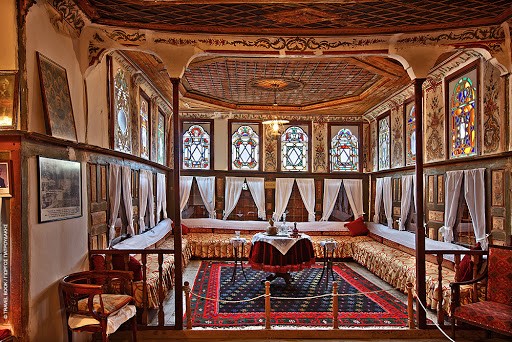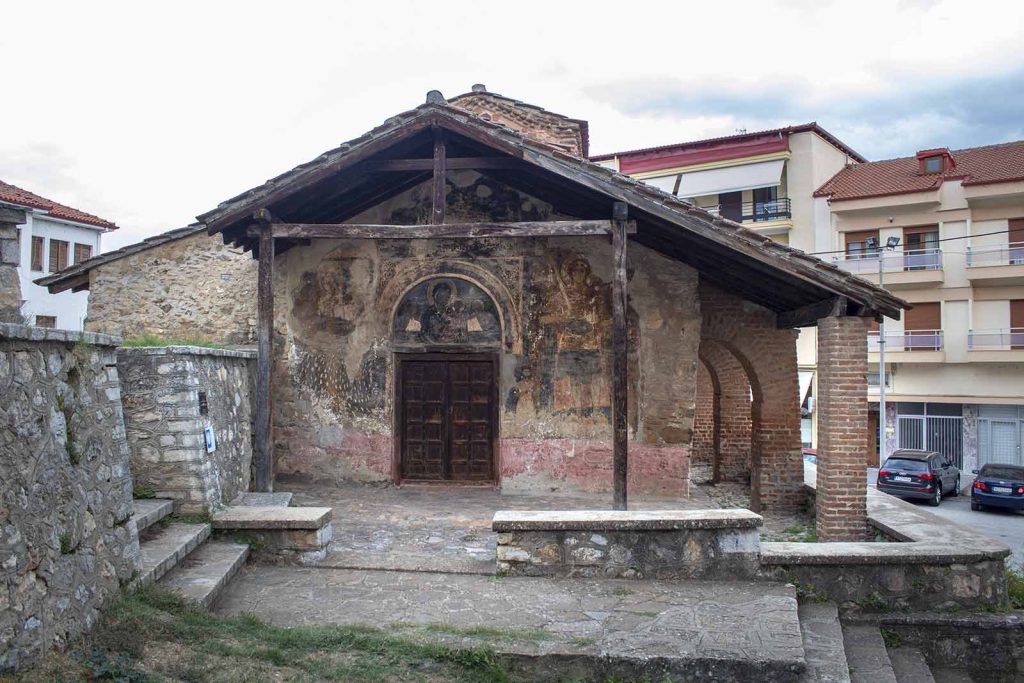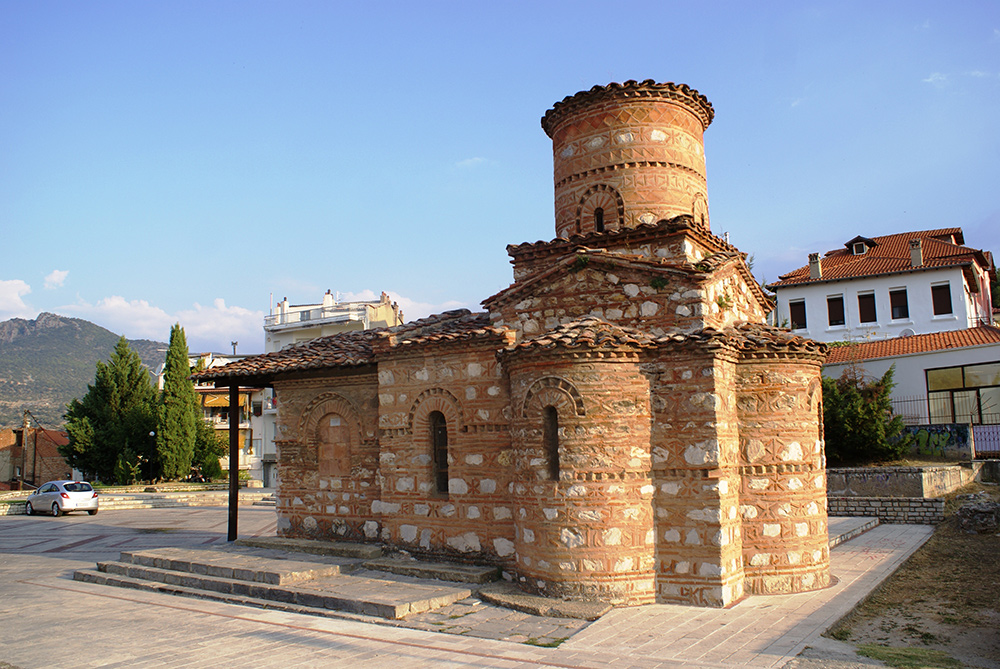Kastoria Tour
Estimated Duration
10 Hours
Estimated Distance
450 Km

Monastery of Panagia Mavriotissa
The monastery’s katholikon is a one-room church with a spacious narthex to the west, located on the perimeter of the lake. It was probably founded in the 11th century and is historically linked to the recapture of Kastoria by the Byzantines after a brief period of Norman domination.
The church is decorated with frescoes in the late 12th and early 13th century. After part of the church collapsed, the katholikon was repaired and the sanctuary and the southern outer wall were repainted in 1259. It is the only monument in Kastoria in which imperial portraits are depicted on the exterior frescoes next to one of the oldest depictions of the Root of Jesse.
According to researchers, this is the depiction of Alexios I Komnenos, associated with the foundation of the monastery, and Michael IX Palaiologos, victor of the Battle of Pelagonia, associated with the renovation of the monastery. The monastery had a rich estate and a close connection with the settlement of Mavrochori on the opposite shore of the lake.
In the first half of the 16th century, a chapel dedicated to St. John the Theologian was added to the south side of the katholikon and decorated with frescoes in 1552, the work of the painter Efstathios Iakovos, prothonotary of Arta.

Archaeological Museum of Argos Orestiko
The museum is housed in a hall of the Cultural Center of the municipality of Argos Orestikou. It hosts findings from excavations at the central part of ancient Orestiada. The exhibits are divided into four seasons: the early Archaic, the late Archaic, the Classical periods and the period of Philip’s reign. It also includes antiquities from the period between the Roman conquest of Orestiada (200 BC) and the establishment of ancient Dioklitianoupoli (around 300 AD). – Copyright © wondergreece.gr

Prehistorical Lakeside Settlement of Dispilio
The Dispilio Lakeshore Prehistoric Settlement is one of the most fascinating archaeological sites in northwestern Greece, situated next to the city of Kastoria.
Near the modern village of Dispilio, a community close to Kastoria with which they share Lake Orestiada, lies the settlement that offers a great deal of information on prehistoric life in the area.
It is located in Nisi, on the south shore of Lake Orestiada, where archaeologists have discovered thousands of artifacts from the Neolithic Era.
A fascinating recreation of the lake dwellers’ settlement has been erected near the site, which attracts tourists from Greece and abroad. There is also a model of the prehistoric settlement in the exhibition with huts made of straw or straw and clay, with objects and utensils that were discovered in the lake.
The prehistoric lakeshore settlement was discovered during the dry winter of 1932, which lowered the level of the lake, where remains of wooden stakes revealed traces of the settlement at the point that separated a small islet from the shore of the lake.

The Cave of the Dragon
The Cave of the Dragon is located in the northern part of Kastoria, close to the lake of the region as well as the monastery of Panagia Mavriotissa.
The main characteristic of the cave is the large number and variety of stalactites and stalagmites. It includes 7 underground lakes, 10 halls, and 5 passages.
The big hall covers an area of 45×17 square meters and the temperature of the cave is 18 degrees Celsius all year round, regardless of the outside weather. The humidity of the cave is 90%. The Cave of the Dragon is one of the most impressive in Greece. It is also a great source of historic knowledge since scientists have found traces of human presence and a fossil of the “cave bear”, which are 10.000 years old.
The cave was discovered during the ’40s from local amateur explorers, while the systematic research from the Hellenic Institute of Speleological research started during the ’60s. Thus, the parents in order to prevent their children from entering the cave came up with the story of a Dragon who guards the “treasure of the cave”. This is actually the source of the name of the cave.
Byzantine Museum of Kastoria
The museum stands at the highest point of the city, in Dexamenis Square (Platia Dexamenis), next to the Monuments Museum. It has been open since 1989. It has a collection of some 700 icons from the city’s 75 Byzantine and post-Byzantine churches, and almost all of them have been restored and cleaned by the museum’s conservators. Of this large collection, 35 icons are on permanent display.
They date to the 12th to 17th centuries and are divided into six groups on the basis of their age and the atelier which produced them.
The most important icons are of: Elijah (12th century) in the severe Comnenian style; St. Nicholas (12th century) on a silver ground and surrounded by ten scenes from his life; Christ Pantocrator (14th century); Saints Cosmas and Damian (14th century); the Panagia Glykofiloussa and the Deposition from the Cross (late 14th century); the Man of Sorrows (15th century); an altar door (15th century) bearing a depiction of the Annunciation and busts of David and Solomon at the top; the Annunciation (16th century); the Christ Pantocrator (16th century) painted by a well-known icon-painter named Ioannis Permeniotis; the Panagia Hodegetria (16th century); and the Dormition of St Nicholas (16th century). In the semicircular part of the exhibition space are displayed three outstanding works by Kastorian ateliers: an icon of St. Paraskevi carrying her own head, and two altar doors with a representation of the Annunciation.
Until 1998, the museum ran an educational program for ten- to seventeen-year-olds titled “In the World of Byzantine Icons”, and one of its aims for 2000 is to resume the program. It involved a guided tour of the museum and a detailed account of the stages of the making of an icon, accompanied by related activities and games.

Folklore Museum of Kastoria
The Kastoria Folklore Museum is housed in one of the city’s loveliest and oldest town houses, the Nerandzis-Aïvazis residence by the lake. The museum has been operating since 1972 and is run by Harmony, a music and literary society.
The two-storey premises were built in the 16th or 17th century and survive in such good condition that the museum was able to open without the need for any restoration work. All the original furniture is still there.
On the ground floor, there are three cellars: one, the wine cellar, contains the wine press, the wine barrels, and baskets for the grapes; another was where pickles, oil, olives, preserves, butter, and cheese were stored; and the third contained cereals, pulses, and flour. It was here that pies and bread were made. Wood and coal for heating were also kept on the ground floor. And in the courtyard are the well, the boat shelter, and the kitchen.
There are two family living rooms on the first floor, one for summer and one for winter, the former also being used as a fur workshop. It contains the first sewing machine for furs, which came from France in 1884. On the second floor there are two bedrooms, one for the husband and wife and one for the children, a small sitting-room, and a large sitting-room, which was the main reception room. The latter was used on festivals and holidays. It contains a suite of furniture with the traditional places for the hosts, the Metropolitan, and the Turkish dignitaries, and in the jetty are low tables for the other guests.
Above the bedrooms is a balcony, whence the unmarried women could observe the official ceremonies and celebrations in the house. On this floor there is also a lavatory with a secret passageway out of the house, whch was useful in emergencies.

Holy Church of the Taxiarch of the Metropolis
The Holy Church of the Taxiarch of the Metropolis (Greek name: Ιερός Ναός Ταξιάρχη Μητροπόλεως) is beside the Metropolis (Cathedral) and metropolitan palace of Kastoria.
The church is dedicated to the Archangel Michael, and was built in the 9th century on the ruins of an early Christian basilica, and possibly served as a cemetery.
The church has many remarkable frescoes. The oldest ones date from the beginning of the 10th century and are preserved fragmentarily on the eastern walls of the three aisles and in the narthex. The frescoes of the second layer, in the sanctuary and in the central aisle, were done in the years 1359-1360, when the temple was renovated and frescoed again. The frescoes on the outer western wall of the narthex, according to the relevant inscription and the style of the representations, date to the second half of the 13th century.
In a larnax in the southern aisle of the church, are entombed the bones of the Greek-Macedonian freedom fighter Pavlos Melas and of his wife Natalia.

Virgin Mary Koumbelidiki
At the acropolis of the Byzantine castle of Kastoria one of the most famous and most remarkable monuments of Macedonia, the sacred temple of PanSaint Kastriotissa or Koumbelikidis, emblem and real jewelery of the city. It was named Kastriotissa in the Byzantine era, as it appears from an inscription that existed at the base of its dome because it was very close to the walls of the castle. It is more known, however, as Koumbelidiki, a name that prevailed during the Ottoman rule (ca. 1383-1912) and derives from the Turkish word “koumpes”, meaning a dome, because it was the only church of Kastoria that had a dome.
The temple probably dates back to the middle of the 9th century, although other views on its dating were made in the middle of the 10th and the first half of the 11th century. During the Greek-Italian War (1940-1941) a large part of his dome was destroyed by bombardment, and in 1949 the monument was restored and returned to its original form.
Architecturally, the temple is the only one in Kastoria that belongs to the square triangle type. Its plan is square and its three sides, the east, the north and the south, end in niches.
The square is covered with a circular dome, disproportionately high in relation to the volume of the building. To the west there is an elongated splint, and a large exarchate that was added in the 15th century. Of particular interest is the formation of the exterior surfaces of the church, which is characteristic of the Byzantine architecture of Kastoria. The walls are made of stones in their natural shape or roughly chipped, framed with plinths, horizontally or vertically. Between them there are briquettes that form decorative letters or geometric shapes and special toothed bands, while the ensemble is enriched with brightened glazed colored squares, squares, rectangles, triangles or in the shape of a diamond.

